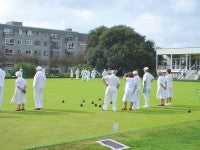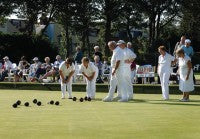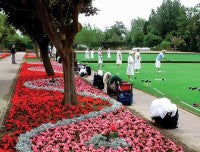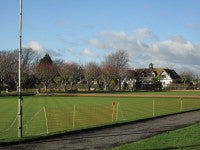Fair wind or foul for bowls?
 "We may be witnessing the quiet demise of another national treasure, with barely a whimper heard"
"We may be witnessing the quiet demise of another national treasure, with barely a whimper heard"
On the face of it, the prospects for what, some say, is nothing less than a British institution, look bleak - ones made all the more calamitous by the predicted impact of the biggest council budget cuts in living memory. Detractors say cuts must come somewhere, and they point to an ailing sport characterised by falling numbers of participants and an ageing player profile.
When one of the oldest bowling greens in the country - Plymouth Hoe, the former playground of England's most famous Elizabethan explorer, Sir Francis Drake - reportedly faced closure earlier this year, fears grew over how long greens provision and clubs themselves could continue in the face of falling income and player numbers. A national media outcry duly followed, which has since died down as the full facts have emerged.
However, councils across the UK are facing often painful decisions on how to maintain and fund these sporting green spaces and their pavilions. Yet, bowls presents quite a different challenge than do most sports, in part because of its greater maintenance requirements and the fact that bowls greens can really only be used for this one sport, unlike other multi-use municipal pitches that can cater for football, rugby and general public use.
Plymouth City Council, who maintain 'The Hoe' - scene of one of the most dramatic episodes in English history as Drake was told of the advancing Spanish Armada, only to continue with his beloved sporting pastime - have, in fact, taken a course of action favoured by a growing tally of local authorities.
They have embraced the Coalition's 'Big Society' vision by offering to transfer the running of their bowling greens (and some public playgrounds) to the local community.
The council curre ntly runs eight greens at an annual cost of £160,000, but the deep cuts to budgets and resources have forced it to radically rethink current practices in a bid to keep them all open.
ntly runs eight greens at an annual cost of £160,000, but the deep cuts to budgets and resources have forced it to radically rethink current practices in a bid to keep them all open.
"There are no plans to remove any bowling greens in the city," a council spokesperson told Pitchcare. "The proposal to transfer some of the council's playgrounds and bowling greens to local community ownership is set out in the budget service delivery plans, and is being considered as part of the focus on 'Big Society' and efficiency."
Yet, the details surrounding any transfer, including tenure, costs and services, would have to be worked through and each individual opportunity might have to be "structured differently".
Plymouth's decision to relinquish control of its greens is not without precedent. It has already successfully leased several pavilions to local clubs for them to administer.
The Hoe was merely a high profile example that touched Britain's historical sensitivities. If the reportage brings the plight of bowls to a wider audience, it will have served an important function. Otherwise, we may be witnessing the quiet demise of another national treasure, with barely a whimper heard.
The authority had sought guidance elsewhere before taking its decision, the spokesperson added. "Other councils have successfully passed greens over to clubs who now lease and maintain the greens, so we are keen to discuss this in a planned approach, which considers what's best for the life of the greens."
The Hoe could form part of this move away from council control to a mix of community and private club use. "The Hoe bowling green is an immensely popular and well-used site, and one that has long been at the hearts of many players in the city," the spokesperson said. "The council is simply looking a t ways to ensure the bowling green's future for everyone, but a potential transfer of the lease has yet to be discussed."
t ways to ensure the bowling green's future for everyone, but a potential transfer of the lease has yet to be discussed."
Community transfer may prove the saviour for bowls in Plymouth, and the same looks true in the North-East, where the sterling work of one local bowls association has recently come to the aid of six of Darlington's greens, resulting in the borough council's commitment to overcome budget cuts and inject vital funds to help continue the sites' livelihood.
Newly-formed Darlington Bowling Association (DBA) has struck a deal with local councillors and officers to counter spending cuts that had put the crown greens under risk of closure.
Members of the town's bowling community met before Christmas with council figures, including deputy leader Cllr Bill Dixon, Head of Street Scene Brian Graham, and Cllr Mark Burton, whose ward includes some of the threatened greens, to discuss the future of the sport.
Eighty of the town's bowls players attended the meeting at Rolling Mills Club, which saw some of the senior figures from the sport in the town forming the association.
The long-term future of the greens is still said to remain in doubt, but the formation of the DBA and successful lobbying of the council has brought a reprieve for them.
A combination of an increase in bowling fees, and a £5,000 donation from Darlington Primary Care Trust, has helped ensure that six public greens - four from the threatened list - remain open. "In principle, all six greens will be kept open for the coming season," explained DBA chairman Malcolm Cundick.

"That gives us this season to fully assess the situation and take a more proactive role with the greens and with the parks department. These changes are vital for the future of bowling in our town," he added. "But, they come at a price to players."
The planned cuts to the four greens formed part of Darlington Borough Council's wider spending review to save £30,000 from the Street Scene budget as part of proposals to slash £22m from its budget by 2014.
"Our budget proposals do include the potential closure of a number of bowling greens," Cllr Dixon said, "but, we have been able to secure a one-off sum of external funding - alongside an agreement that members of the club will pay double fees."
These two actions would extend the time available to club members to find new ways of funding and running the clubs, "independent of council funding," he concluded.
Some authorities have seen the writing on the wall and acted before they were forced into taking emergency measures. Rhondda Cynon Taff county borough, for example, took pre-emptive action last year when it introduced self-management of all but six greens and facilities.
The council runs twenty-eight bowling greens and several bowls leagues use the sites, "predominantly, the middle to elderly age range," notes Parks Operations Manager, Martin Sullivan. "Clubs vary in how they market themselves, and some are active in encouraging younger players to join," he adds.
All bowls clubs using the greens can use them free of charge, but must ensure the sites remain clean and tidy as there are no longer any bowls attendants (seasonal posts) to look after the day to day running.
Rhondda Cynon Taff still pays all utility bills, maintains the pavilions and the greens - the latter cost on average £10,000 to tend, says Sullivan. "We made the efficiency savings on attendants' wages, in total about £120,000 a year," he adds, "and feel we have come to a status quo on bowling provision. The council is not looking to make further savings."
 The remaining six greens - in Pentre, Darran, Taff's Well, Ynysangharad, Aberdare and Mountain Ash parks - are available for public use. "It's proved to be a win win result for everyone," Sullivan maintains.
The remaining six greens - in Pentre, Darran, Taff's Well, Ynysangharad, Aberdare and Mountain Ash parks - are available for public use. "It's proved to be a win win result for everyone," Sullivan maintains.
Safe haven
If there is one spot where the future of bowls is surely not in doubt it is in Worthing, West Sussex, the hub of the sport and home to the governing body for the flat game, Bowls England.
As the location for some of the game's biggest national events, the Worthing centrepiece site at Beach House Park, right on the beach-front, is one place where "money is safe for the coming year," says Worthing and Adur District Council, which is preparing to host the summer's home and international tournaments.
Home to five plush surfaces, worked on year-round, Beach House Park hosts the men's national and Sussex county championships and sits next to the offices of Bowls England, who keep a close eye on the condition of the greens and work closely with the council to ensure they meet the high standards required to stage world-class competition.
Key to the role of delivering premier surfaces and provision that fully meets players' requirements is the relationship between the council and its longstanding contactor, Continental Landscapes.
In Worthing, their role has moved beyond traditional duties to embrace elements of bowls provision and maintenance that might prove a blueprint for helping the sport survive.
In charge of the town's green spaces and parks for eight years, under a ten-year agreement, the contractor works closely with Parks Officer, Bob Baker, who spearheaded the move to a contracted-out service after drawing up maintenance schedules for the council's greens, sports pitches and other playing surfaces.
"We decided to take the bull by the horns when the compulsory competitive tendering process came into force in 1989," Bob explains, "so put everything in one basket, believing it to be more cost effective in the long run. All our parks, open spaces, sports pitches and allotments have been contracted out for over twenty years now."
The turnkey contract includes security control in the parks, as well as full maintenance of the council's greens and much more besides, Bob continues.
"It's not your average amenity set-up here. We always aim to provide a premier surface but, far from just carrying out the obvious work, Continental also look after the membership fees for the bowling clubs in the town, which takes much of the stress off us."
The process also allows participation figures to be monitored closely but, as contracts manager Andy Collins confirms, "Attendances here have fallen steadily over the years.  We are not immune to the problem of participation in bowls." A state of play that may bring a change of heart, as Bob notes. "Despite the status of the site, we know we are not immune to cuts, so this next year will be one where we make some tough decisions on investment in bowls."
We are not immune to the problem of participation in bowls." A state of play that may bring a change of heart, as Bob notes. "Despite the status of the site, we know we are not immune to cuts, so this next year will be one where we make some tough decisions on investment in bowls."
"It's important that we weather the financial storm and come out of it with a positive long-term strategy for raising the profile of the sport in the town, and look at where we can improve on the quality of the turf. So far, the Bowls England's monthly reports have been positive and we're on the right track."
The yearly maintenance routine is what one would expect from a national sporting venue that has to ensure its five championship greens remain in prime condition.
"Our philosophy has always been that if you complete the hard work done in the autumn and winter, and get it right, summer maintenance is straightforward," explains Bob.
"Worthing is not really representative of bowls throughout the UK, as there is more money and prestige involved here and the greens are well scrutinised throughout the year, so we cannot afford to let standards slip."
The regular autumn works follows a three-pronged approach - first, deep scarifying in three or four different directions, then overseeding and topdressing in the autumn, together with spiking and vertidraining as the weather dictates. 
The council-contractor relationship allows changes in working practices to be introduced seamlessly as greenkeeping maintenance moves with the times, Bob stresses. "The focus used to be on the surface looking good," Bob recalls, but our focus is now more on the rootzone. It's more about plant health now and we apply more liquid feed and amino acid treatments."
"Cultural methods have become more the norm here, with the science behind what we do dominating our workload," adds Andy. "The qualified groundstaff coming through the ranks now are more well versed in the science and keener to act on the advice of agronomists, through liaising with STRI and other bodies."
Recent soil surveys have highlighted where changes or improvements can be made. "The reports found potassium, magnesium and cobalt deficiencies in the greens, but good potassium levels," explains Bob.
"We can use these most recent findings, alongside the annual STRI studies, to look to modify our practices to remedy these issues. It's about combining traditional with more modern methods, which means we are more reactive with chemicals, applying them only when necessary."
Even the home of bowls has suffered with disease. "We've had issues here," reveals Bob, "the worst probably being an outbreak of dollar spot just two days before a national championships. We have to weigh up the costs involved with a preventative approach. After all, everything you do on a green costs money, so savings have to be made where we can."
"The problems with maintaining turf well, when you are in the council sector, is that few people realise the huge cost and time involved with doing a good job. It's always underestimated by those who hold the purse strings."
 Beach House Park is close to the hearts of local and national bowlers alike, yet numbers in membership have dwindled year on year. "Ticket sales and annual memberships are continuing to slide," explains Andy, "largely through natural wastage, with the older members passing on or simply being too elderly to continue playing."
Beach House Park is close to the hearts of local and national bowlers alike, yet numbers in membership have dwindled year on year. "Ticket sales and annual memberships are continuing to slide," explains Andy, "largely through natural wastage, with the older members passing on or simply being too elderly to continue playing."
"It's partly our role to look for ways to turn the tide on this trend, which we're keen to do for the other six greens in the town, some of which are already showing positive signs of a turnaround."
Aside from Beach House Park, another six greens are run in the Worthing area, with differing fortunes," Andy reports. "Usage of the greens across the town has been mixed, with some clubs simply not acting to attract more players, while others have chosen to tackle their problems head on and are achieving great success."
Two of the most heavily patronised sites - Field Place and Marine Gardens - demonstrate bowls' fight for survival and the challenges the sport faces nationally.
Field Place had been through tough times, with participation so low that closure was looming. But, after croquet was introduced, popularity ballooned. "The success there has been great so far, and they are over the moon with how membership is taking off," Andy enthuses. "It goes to show that if the market is right, minority sports like croquet and bowls can survive."
Marine Garden was also struggling to retain participation levels as separate men's and a women's club until it decided to merge and offer mixed bowls - a move that has proven the tonic needed to revive numbers.
"Today, couples increasingly want to enjoy their leisure time together, not independently," Bob says, "so, the days of single sex clubs are fast disappearing, as many  simply cannot afford not to. Many clubs are still against mixed bowls, and that may well be part of the reason why the sport has struggled in recent years to move with the times and embrace changes. In my time here, I've found that where there's mixing there's success," he adds. "Marine Gardens was going downhill fast until it introduced change, so we're keen to fight against traditions that slow down the progression of what is a fantastic sport."
simply cannot afford not to. Many clubs are still against mixed bowls, and that may well be part of the reason why the sport has struggled in recent years to move with the times and embrace changes. In my time here, I've found that where there's mixing there's success," he adds. "Marine Gardens was going downhill fast until it introduced change, so we're keen to fight against traditions that slow down the progression of what is a fantastic sport."
Proof of the intent among many of Worthing's bowls clubs is seen in the wealth of competitions and events that the town now stages, such as the Worthing Unified Open, a mixed tournament established in 2009 that fits with Bowls England's long-term vision to broaden the game's appeal and drive up recruitment.
"The change of outlook from Bowls England really came in January 2008 when the Women's English Bowls Association (WEBA) and the English Bowls Association (EBA) amalgamated," explains Alistair Hollis, the governing body's development officer.
"We recognised that the biggest challenge for our sport was keeping the numbers up, and felt that this could be best approached as a unified body with the men's and women's game working as one."
Problems with recruitment and a steady decline in membership numbers have been the biggest cause for concern for a sport that has been tainted by a stereotypical view by outsiders, and a struggle to get the broadcast coverage vital for all sports to broaden their appeal.
In the last ten years, annual membership figures released by Bowls England show a fall from 165,545 in 2001 to 122,458 calculated for the coming 2011 season.
 "Every sport has a certain amount of natural wastage," says Hollis. "It's unfortunate that ours has traditionally had more, as we have always been seen as a sport for the older generation."
"Every sport has a certain amount of natural wastage," says Hollis. "It's unfortunate that ours has traditionally had more, as we have always been seen as a sport for the older generation."
A belief not only "misleading" but "totally incorrect", he insists. "It's part of my job to ensure that all ages are exposed to and can access the sport. What we are working towards is knowing the best ways to attract younger people."
"It's no use trying to attract young people with an advert in a free local newspaper. This approach is still relevant for some sports, but we can no longer rely on the same methods of recruitment and advertising - we need to utilise valuable new social networking media like Facebook and Twitter."
As part of this drive to make the country's 2,500 bowling clubs more in touch with the best ways to increase recruitment, Bowls England is rolling out plans over the next years to run a series of seminars and workshops, spearheaded by Hollis, which will help show clubs how they can tap into new avenues in their areas.
"There's no 'one size fits all' solution. Each club has to be willing to be active and look at their own demographic and what the best means to attract members are. An inner-city club will not operate in the same way as one in rural West Sussex, but it's my job to make sure people know what they can be doing."
While the image of the sport is one still dominated by that of an older generation, at the elite level the picture is a very different one, with the recent visit to India to compete in the Commonwealth Games demonstrating the high level of talent coming through at junior level.

The majority of the England team that went to the Games, the sport's premier event, were under 35 and saw two of their youngest players take the biggest honours - 21-year-old Natalie Melmore winning the women's gold medal in India and Sam Tolchard, also 21, being pipped at the post for a bronze medal, coming in fourth.
This is the vibrant, younger image that Hollis and Bowls England want to get across, and the way the sport needs to move in future. "The Commonwealth Games has shown that there is real quality at the younger level, yet this rarely gets any attention from the broadcast media, which could massively boost the appeal of the sport," he says.
"The comment you always hear about bowls is that people are too young to play the sport, and that it's an old people's game. Yet, actually, it's the only sport that spans the ages and can be played by anyone from eight to eighty-eight! And, when people do take it up, they always say they should have started earlier. We need to continue to push on and ensure that we can reverse the trend in membership, and allow the sport to be enjoyed by people of all ages, from all backgrounds and of all abilities - something that you cannot say for too many other sports."

